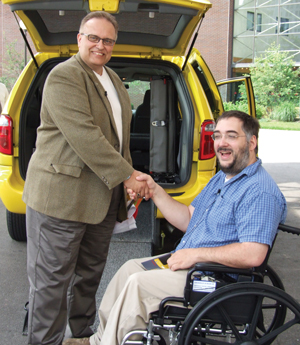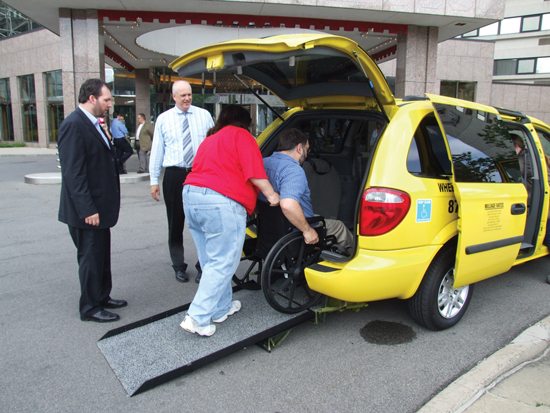|
||
 |
Bill Yuhnke, owner of Liberty Cab in Buffalo, NY, is shown greeting a passenger by one of Liberty’s accessible taxicabs. |
Each of these situations, their costs and long term benefits to taxi companies, users and communities alike are discussed within:
- This report addresses the issue of ADA mandated taxicab service through the documentation of costs and operational difficulties resulting from the local expansions of ADA type legislation.
- To determine accurate costs the research team interviewed various ADA approved vehicle distributors in North America and verified their cost findings through interviews with North American taxicab companies.
- Practical difficulties are analyzed in this report through research and interviews with taxicab companies already operating ADA compliant vehicles.
- The actual demand or public need for accessible taxicabs at airports, based on data from the top fifty (50) North American airports, is also detailed.
- Finally, an interactive cost analysis spreadsheet is included so that local taxicab companies and authorities can easily calculate the estimated costs for implementing ADA approved vehicles within their community.
The practical difficulties in the taxicab industry that arise from the enactment of local ADA type initiatives include additional incurred fixed and variable costs, low demand, and greater service time consumption resulting in lower revenue per trip and per vehicle. However, there are various alternatives and incentives for ADA compliant taxi vehicles and companies to overcome these practical difficulties. Communities should not simply mandate wheelchair accessibility without consideration of these practical difficulties.
The successful integration of taxicabs into this ADA accessible market depends upon existing regulatory structure for taxicabs, per trip subsidies, other accommodations a taxi company might receive from its local authority and the environment in return for their successful adoption by the taxi industry. Furthermore, agencies, which impose these local unfunded mandates often fail to monitor and evaluate their success or failure once mandated. As an example, some cities have provided new wheelchair accessible taxi permits at a substantially lower cost than standard sedan permits, but have then failed to assess how many actual wheelchair trips are being provided.
Unfortunately, many of the financial costs and benefits associated with these accessible services are not readily known. Through this report, its case examples, and associated cost evaluation software these costs can be replicated and reasonably determined for each local taxi company or driver. In addition, specific recommendations are provided for local authorities on how to make accessible taxicab services more successful in their community.
Overall, the report concludes that a small portion of integrated accessible taxicabs for curb-to-curb service is in the best long term interest of both the public and the taxicab companies. Additional costs of these services are real, however, and must be supported by the communities these taxicabs serve.
A final comment would be that one must consider the taxicab environment when initiating desired ADA taxicab services. If the community has a fractured taxicab system with many individual companies and no real full service taxi companies, implementation of an integrated ADA wheelchair accessible system will be extremely difficult and costly. Some progress might be possible with a centralized dispatch system which requires all taxicabs to accept calls. However, the economic realities are that the human behavior of the typical independent taxicab driver will work against the overall needs of the community to make these services available at reasonable and normal taxicab rates. In these situations, community leaders may have little choice but to directly contract ADA providers that schedule and deliver these publicly provided services.
The entire study, Assessing the Full Cost of Implementing An Accessible Taxicab Program, may be downloaded from the TLPA Web Site at www.tlpa.org.
Hal Morgan, TLPA’s Executive Vice President, provided this article. You may contact him at hmorgan@tlpa.org.

